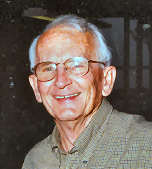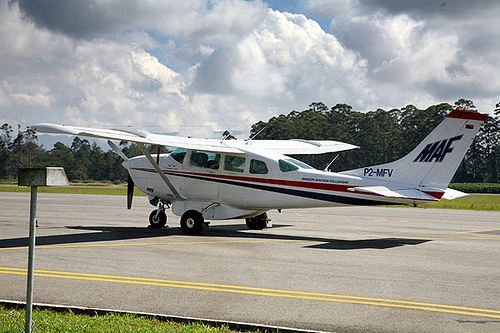|
|
|
Privacy Policy | Editorial Policy | Join the Association | List of Members | Contact us | Index | Print this page |
|
|
|
|
|
TRAINEE PILOT.
– Ron Raymond.
Ron Raymond continues his memoirs from Vol 27. While still at Wagga and part of the way through his studies as a Framie Appy, Ron got the urge to learn to fly. This is the story of his escapades in the seat of several light aircraft at the local civvy flying school.
*****
“I really don’t
recall what initially possessed me to learn to fly. The
Wagga Flying School was located on the same airfield as the RAAF Ground
Training School and had been established by Eric Condon who was an
ex-peacetime, ex-wartime, ex-Airforce, demobilised pilot who had taken up
a commission at the start of hostilities. Eric was one of those
Boy’s Own characters who had packed two life times of adventure into
one lifetime of aviation; when aviation was still an adventure in itself.
I think it was a combination of frustration with the life of an apprentice plus the influences of a somewhat dour old pilot named Eric Condon and a dashing crop duster named Freddie Burke (the latter complete with a piratical facial scar earned in one of the spectacular crashes so characteristic of the day) that spurred my growing interest in flying. I decided to earn a commercial pilot licence and become a crop duster just like my new friend.
Inspired by this ideal and as our fortnightly pay as apprentices totalled just five shillings (50˘), I wrote to my long suffering grandfather for help. Granddad was a lovable old patriarch, despite a relatively short fuse at times; generous to a fault within the limitations of his retirement; he was a true pioneer of Tropical North Queensland. He was one of the few relatives who supported my sister and me while our mother strove to provide for our care with reluctant relatives, guest houses and expensive boarding schools. As it transpired, the old chap had actually set aside a sum for my further education and, seeing that the further education bit had ground to a disastrous halt, he agreed to fund my flying so long as there seemed to be light at the end of the financial tunnel and visible progress toward my goal. I duly complied – anything to become a crop duster.
The Wagga Flying School had
four Tiger Moths, one Hornet Moth, one Percival Proctor (left) plus a
The Widgeon (below) proved to
be interesting in its inadequacies. A
parasol configuration saw a single wing supported by
cabane struts above an open cockpit allowing the pilot to reach the
inboard training edge of both ailerons in flight. I do not recall if the
ailerons were differentially operated to reduce adverse yaw and I doubt if
there was any benefit to be gained from clasping them in flight. I do
remember the fearsome noise from an
A singular advantage of flying the thing was an ability to see over the nose in level flight. I suppose originally this was a sound enough arrangement; however in ‘our’ Widgeon the fuel tended to vaporise in the feed line if the engine ran too long on the ground during summer. We learnt of this when the engine stopped as the aeroplane passed over the boundary fence the first time we tried to fly it; luckily there was a handy paddock ahead and the ensuing forced landing was uneventful. We duly recovered the aeroplane by lifting the tail and pushing it to a position from whence it had enough ground run to become airborne and enough endurance to make it back over the fence before the engine stopped. I really do not know how the owner managed to fly it to Wagga, but fly it he did; complete with spectacles tied around a leather helmet with a piece of string to help him see. I never saw him again after that flight – a circumstance that was possibly prophetic in itself.
Eric’s master plan involved feeding a number of strategically placed satellite clubs; a barnstorming project that involved landing in paddocks by various country towns and promoting the concept with joy rides, aerobatic displays and stunts like mock dogfights and streamer cutting as a prelude to gaining members for the flying school. He had once promoted a demonstration parachute jump and shoved a bag of dry cow pats out of the aeroplane from 1,500 feet, a spectacle we did not repeat after the local constable threatened to run the flying school out of town when two ladies fainted as the cow shit plummeted earthwards. A student accompanied each licensed pilot (and paid for flying associated with positioning the aeroplane) to guide wing tips; strap in passengers and hand swing the propellers to start the Gipsy Major engines. Not that some of the ‘licensed’ pilots had much more experience or skill than the students; I recall one flight from Shepparton to Wagga with a chap named ‘Phiz’ that lasted two full days after losing sight of Eric in low cloud and drizzle. |
|
|
I called this old girlfriend of mine and asked her if she was free on Saturday night. She said no, but she would be reasonable. |
|
|
The normal flying time between Shep and Wagga was about two hours. On this particular trip we landed in a paddock north of Shepparton to find out where we were; then almost crashed on takeoff when the ‘licensed’ pilot forgot to turn the fuel on, (fortunately I had talked him into taxying to the end of the field before opening the throttle - the engine stopped just as he did so.) We landed at Corowa to refuel and promptly became lost again before landing at a village named Walla Walla west of Albury to, once again, find out where we were. We spend the night with the farmer and his family before following the road to Wagga the next day. Our arrival back at the school occasioned Eric’s remark, “So here you are I was wondering where you had got to.”
Fizz’s flying was no better than his navigation – later on he almost collided with me during a formation return from barnstorming at the Wagga Wagga Agricultural show. I can still hear the roar of his engine and see his left wheel a foot or so above my top wing as he desperately banked to avoid a collision.
Although I wonder now at the
memory of it all, we treated flying in the belief that we were bullet
proof and would live forever. We taught ourselves aerobatics of a sort,
climbing through holes in the cloud cover to loop and roll in the
brilliant blue yonder before spinning down through the overcast into clear
air and finding our way home (we had not learnt to fly on instruments and
the Tiger only had a rudimentary set anyway). That was until my engine
stopped in the middle of a mishandled loop-the-loop one day, an event that
was both unwelcome and unplanned. Fortunately I found a hole to dive
through while gaining airspeed and waiting for the propeller to windmill
in an attempted re-start – a drill that I had heard about, that I had
never witnessed but nevertheless
Right, Ron, complete with white scarf, Barny Barnfield and (he thinks) Ron Croft
Throughout all this we were gaining experience and confidence – if anything too much confidence - added to that I became addicted to the adrenalin hit from the ‘rack hack and zoom’ of thrill seeking aviation. Something had to bust; which it did in spades when I hit a tree; nevertheless I achieved something, suddenly I realised I was not immortal. Up until then I had decorated myself with a silk scarf, an item I encouraged to stream back in the slipstream so people would know that the great aviator was flying the machine, an ostentatious gesture copied from the World War One aces despite the risk of strangulation. Thereafter I continued to wear a silk scarf however I did not allow it to trail so freely in the wind.
Letter to the Editor, Air Force News, June 6, 2002.
Aerial Pruning. Above - Bob Kee and Ron. R.A.Kee AO AIRCDRE (Retired)
All of which is how Bob Kee, an apprentice colleague, remembered one of our teenage escapades some 55 years or so after the event. Of course after so long he may be excused for a lapse of memory while, for my part, I still have enough pride to correct the description of the event: first we did not ‘pounce’ on stray aeroplanes – we ‘bounced’ them; second, I would not and did not make ‘straight for the deck.’ although we knew little about air combat at the time, I certainly would not have handed such a massive tactical advantage to the aggressors – I would have held my height, opened the throttle as wide as I dared without wrecking the engine and turned into the bounce with the stick hard back in a maximum rate turn to out-manoeuvre my tormentors. I certainly knew enough to bank as tightly as possible in an effort to outturn an opponent during a turning dogfight; to keep my speed up and never reverse the turn. I was never concerned about two versus one if I was alone - two aggressors only got in each other’s way while I only had myself to worry about. In the best tradition of the Wright Brothers Flyer, biplanes were outstanding in their ability to lose speed and altitude when pressed (just remember to climb, cruise, glide and crash at 65 miles per hour old chap) and the only way to maintain airspeed in a dogfight involved controlled sacrifice of height.
Be that as it may, I
eventually finished up in the weeds although it was not in that particular
mock combat; I was
Anyway what else would a frustrated adolescent have done for kicks? Didn’t everybody aim their aeroplane straight at a stand of gum trees and leave it until the very last moment to pull up? While I can only speak for myself, and while it might sound a touch suicidal, I had often done that in anticipation of coming out the other side undamaged. Here in the early 21st century they speak of youth and its propensity for risk taking; of under development of the frontal lobe, an area of the brain governing caution and conservatism; in retrospect I guess it was also the case during our young lives at the Wagga Flying School. We were just eighteen and adventurous to a fault. Coupled with that we were inexperienced, virtually unsupervised and we still had a lot to learn about flying – a dangerous cocktail at best.
Of course nothing
lasts forever and granddad’s largesse was finally exhausted, fortunately
after I qualified for my civilian pilot licence. The question of continued
support for my flying led to formation of an RAAF apprentice Flt Lts Gooch and Talberg ready to test fly the Merlin 2 at Uranquinty.
In the event the club had an offer that we could not refuse, especially as the Airforce financed the purchase of a broken two seat glider in desperate need of repair. It answered to the name ‘Merlin’ and seeing that it required a fuselage rebuild and was alleged to have a broken wing spar, we added ‘2’ in tribute to its resurrection: The Merlin2.
There was only one impediment to the Blue Triangle Gliding Club’s (as we called ourselves) aspirations; namely a limited repertoire of glider lore, nevertheless where we lacked information and suitable hardware, we compensated with enthusiasm. A Mustang bomb release was fitted as an alternative to an approved tow release; a weird looking spring loaded plate on the wing strut served as an airspeed indicator (a Rattrap Airspeed Indicator was the term of the day) in lieu of a proper glider wheel, a wheel barrow wheel was substituted, two aluminium crew seats from a Beaufort bomber were fitted in the cockpit and, as we did not have any of the circular rubber shock mounts for a skid, we did without them entirely. The actual rebuild of the aeroplane was under the supervision of a wise old Flight Sergeant who insisted on an immaculate finish, a result we achieved: the glider even smelt right.
Unfortunately neither the
wise old Flight Sergeant nor anybody else in the apprentice system knew
anything about launching recreational gliders and the RAAF could only
provide an underpowered truck of sorts called a
Apprentices never gained much benefit from their creation apart from an occasional ride while the Basic Flying School instructors at Uranquinty tried to come to grips with the thing. Nevertheless we continued our efforts to launch the glider with some degree of dignity and consistency, a process that eventually involved wing runners on each wingtip and two runners guiding the tail in an effort to keep it tracking straight; a scene vaguely resembling something out of a Ben Hur epic. Despite our best efforts however, insufficient control authority and inferior weapon carrier acceleration finally combined to place the machine airborne in an uncontrollable wing-over before crashing back to earth with a fearful thump, minimal injury to the crew and complete destruction of the glider. In reality the only injury involved a cut finger belonging to the instructor (Blue Sweeney - a Korean War veteran who was subsequently killed in a Sabre ejection at Williamtown). |
|
|
It's wise to be nice to your kids. They'll choose your nursing home.
|
|
|
Somehow the challenge of gliding intrigued me and I continued the sport with limited success until I left for RAAF pilot training. One memorable aircraft, known as a UT1, had a particularly curious rattle in its wings as it rolled into any turn that lacked balance. At some stage of its life somebody had left ‘something’ inside the wing; an omission that served to remind us whenever we became slack in our handling. The glider had a fabric covered tube steel fuselage, a wooden fabric covered shoulder wing, an open cockpit with a single seat ahead of the wing, a regular tow release, a proper glider wheel, conventional rubber springs for the skid; an altimeter to reveal its altitude and a ‘real’ airspeed indicator. Modern gliders are judged by a number of factors one of the more important being the power of their airbrakes. The UT1 had no airbrakes; the pilot either judged his approach correctly or resorted to a sideslip to shed surplus height. Any undershoot involved a rapid change of plan and a frantic touchdown short of the boundary fence.
With the heady acquisition of
the UT1, the Club embarked on an expansion program and purchased a H17
glider in Northern NSW. In reality we had gained another wooden single
seater of an even earlier vintage, an open cockpit strut braced high wing
machine of pre-war design – almost a shrunken Grunau Baby for gliding
Actually it was a pity it was not the UT1 that ditched. With its tube steel fuselage it would have sunk rather quickly and saved a lot of grief. The UT had a mass balance on the front of the elevator spar; this mass balance comprised a tube steel arm with a lead weight on the end. Over the years the tube had bent due to metal fatigue and eventually jammed a bell crank that operated the elevators. The pilot was left with full-up elevator during a wire launch and crashed following a series of stalls as he fought to regain control. The crash was fatal. |
|
|
Did you hear about the blonde who got locked in the toilet? |
|
|
Max Meyers
Max Meyers (right) got in touch, through the grape vine. He was looking for Mike Lancaster but unfortunately we had to tell him that Mike died back in May 2003. He responded.
“Perhaps it’s a feature of increasing age (!) but it seems I recall my RAAF memories more and more these days. Thank you for verifying the story I had picked up somewhere along the way about Mike Lancaster’s death. I’ve often wondered whether his death had anything to do with the fact that when I saw him in 1957 in South Australia he was flying a Lincoln, based at Edinburgh, through the post-detonation clouds at Maralinga ... to collect air samples! He asked me to come along with him for the ride but (with hindsight ...thankfully) I had other commitments and couldn’t do so”.
“I may have seen him once again, in PNG, I can’t recall”.
“I resigned from the Air Force in 1961, at the exalted rank of Flying Officer, after only 6˝ years of service. As Lancaster used to say I “took the cloth” and joined Mission Aviation Fellowship, flying for 10 ˝ years (9,500 hours ... a lot of work) all over that fascinating country (PNG).
MAF Cessna 206 at Mt Hagen airport
I was brought back to Melbourne in 1972 and after a few years in management I became MAF’s CEO, leading a fantastic team of people using 32 aircraft from Bangladesh to the Solomon Islands. In 1985 I was appointed CEO of MAF-US ... and the rest of the world became my field of operations. I have basically lived in the US since then. We had a total of about 140 aircraft working in 40 countries. We did church work, of course, but hundreds of thousands of hours in famine and other natural disaster relief, medical, educational and other development work. It was a far cry from the pure fun of flying Meteors with 75 Sqn or Canberras with 2 Air Trials Unit. I missed the RAAF, the camaraderie ... and the sophisticated aircraft! But in many ways the RAAF experience was, for me, a preparation for the most fulfilling and rewarding flying I have ever known.
Having wandered through and had worked in more than 180 countries it is time for my wife and I to become Aussies again ... and I’m enjoying the experience. Still working, though. Now with a US-based Christian leadership organisation trying to help leaders achieve higher levels of integrity and be more effective in their leadership. I have worked for the past few years mainly in Russia and in the South Pacific with assignments in Africa and India. In another few years it might be time to retire!
The memory of Mike Lancaster, Ron Raymond and so many other wonderful men is a source of joy. I have been privileged to be named among their friends. Mike Lancaster was truly worthy son of the old British House of Lancaster. It had never been confirmed to me that he had died, but I picked it up as a possibility somewhere along the track. I was looking through some old photos recently and found one of him, when we were training (22 Course) in 1955 at Uranquinty. There was something very impressive about him.
I valued him deeply as a friend and feel so sad that in the very different directions life has taken us we somehow got separated along the way. If he had any kids (and like most of us, he probably did) I would love to tell them what a great man their Dad was! |
|
|
The name Coca-Cola in China was first translated to “Ke-kou-ke-la”. |
|
|
Back Go to page: 1 2 3 4 5 6 7 8 9 10 11 12 13 14 15 16 17 18 19 20 Forward
|

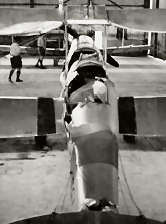
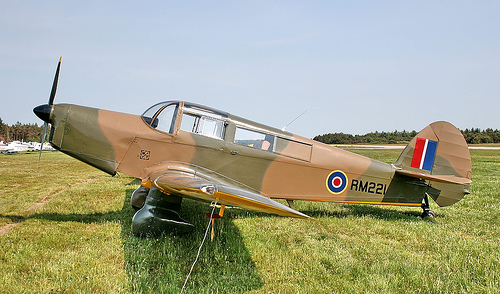 n
inherited Westland Widgeon. I found Tiger Moths both cold and
uncomfortable and our variants had bucket seats for parachutes that we
didn’t wear, consequently we had to sit on a cushion which made us unable
to see ahead over the cockpit coaming. All of which was a small enough
inconvenience when we could simply pull our goggles down, lower the
cockpit side flaps and lean into the slipstream to watch the world ahead.
The Flying School actually owned a couple of dilapidated parachutes
however while they looked gung ho enough to wear around the tarmac in
front of airline hosties and assorted pretty girls, we were never prepared
to trust our lives to them.
n
inherited Westland Widgeon. I found Tiger Moths both cold and
uncomfortable and our variants had bucket seats for parachutes that we
didn’t wear, consequently we had to sit on a cushion which made us unable
to see ahead over the cockpit coaming. All of which was a small enough
inconvenience when we could simply pull our goggles down, lower the
cockpit side flaps and lean into the slipstream to watch the world ahead.
The Flying School actually owned a couple of dilapidated parachutes
however while they looked gung ho enough to wear around the tarmac in
front of airline hosties and assorted pretty girls, we were never prepared
to trust our lives to them.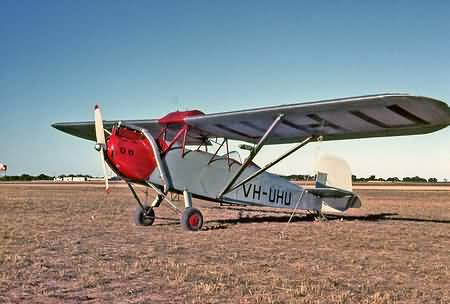
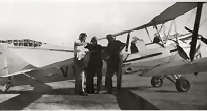
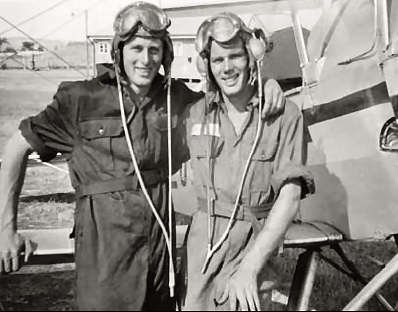
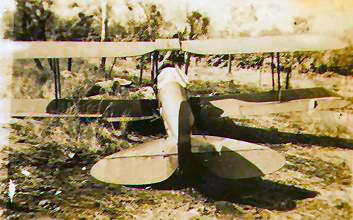 simply low flying, seeing how close I could fly to the trees without
hitting them, an event I inevitably celebrated by colliding with a ghost
gum and shearing the bolt securing the radius rod to my left wheel strut.
Without this bolt the left wheel obediently folded back under the Tiger
when I landed in a paddock to check ‘if I had busted anything.’
Fortunately the machine didn’t catch fire – something attributable to the
lack of significant damage and the fact that it was still right way up.
Bob is correct when he describes the agriculture falling out of my cowl
and how my apprentice friends rose to the occasion and helped work off
most of the consequent debt at five shillings an hour. As the man said, it
was good lesson; although it failed to quell my lust for the occasional
unrehearsed beat-up.
simply low flying, seeing how close I could fly to the trees without
hitting them, an event I inevitably celebrated by colliding with a ghost
gum and shearing the bolt securing the radius rod to my left wheel strut.
Without this bolt the left wheel obediently folded back under the Tiger
when I landed in a paddock to check ‘if I had busted anything.’
Fortunately the machine didn’t catch fire – something attributable to the
lack of significant damage and the fact that it was still right way up.
Bob is correct when he describes the agriculture falling out of my cowl
and how my apprentice friends rose to the occasion and helped work off
most of the consequent debt at five shillings an hour. As the man said, it
was good lesson; although it failed to quell my lust for the occasional
unrehearsed beat-up.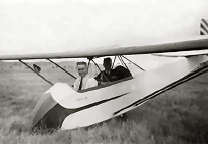 gliding club, something the service seized on in the mistaken belief that
if it was not an appropriate interest for budding airmen it would at least
keep some of them out of mischief; at least stop them trying to shoot out
the security light on the ammunition store across a railway line from our
quarters or steal a railway ‘jigger’ and head for Wagga via the same
railway line that ran through the Base. We duly started construction of a
Heath Robinson affair called a Dixon Primary Glider. I eventually flew the
thing but not at Wagga and even that provided a measure of excitement when
an aileron bracket failed and the pilot lost control as the glider rolled
over and crashed upside down in a railway culvert – its nose skid on one
side of the train track, its tail on the other and the pilot hanging
uninjured in his seat strap.
gliding club, something the service seized on in the mistaken belief that
if it was not an appropriate interest for budding airmen it would at least
keep some of them out of mischief; at least stop them trying to shoot out
the security light on the ammunition store across a railway line from our
quarters or steal a railway ‘jigger’ and head for Wagga via the same
railway line that ran through the Base. We duly started construction of a
Heath Robinson affair called a Dixon Primary Glider. I eventually flew the
thing but not at Wagga and even that provided a measure of excitement when
an aileron bracket failed and the pilot lost control as the glider rolled
over and crashed upside down in a railway culvert – its nose skid on one
side of the train track, its tail on the other and the pilot hanging
uninjured in his seat strap. 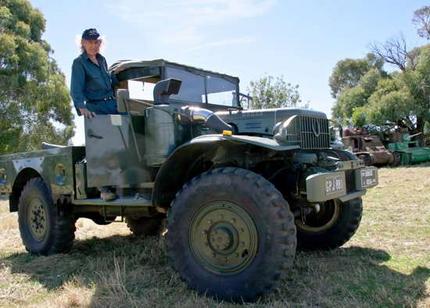 weapons carrier as a tow vehicle. With a little help, the weapons carrier
produced acceleration such that the Merlin wallowed behind barely under
control let alone airborne. Occasionally the glider did lift-off and after
gaining the few knots that made all the difference, control was achieved
and the Merlin 2 climbed away in all its glory; unfortunately by that time
the truck had usually run out of aerodrome and the climb was limited to
about 800 ft; enough to fly a circuit and land again, certainly not enough
to ‘catch a thermal’.
weapons carrier as a tow vehicle. With a little help, the weapons carrier
produced acceleration such that the Merlin wallowed behind barely under
control let alone airborne. Occasionally the glider did lift-off and after
gaining the few knots that made all the difference, control was achieved
and the Merlin 2 climbed away in all its glory; unfortunately by that time
the truck had usually run out of aerodrome and the climb was limited to
about 800 ft; enough to fly a circuit and land again, certainly not enough
to ‘catch a thermal’. 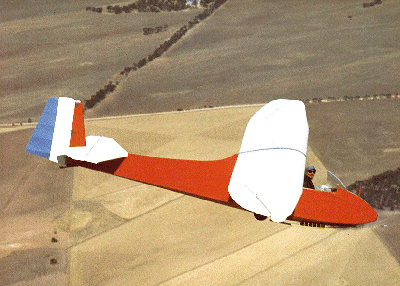 historians.
Unfortunately I never flew the aircraft as the tow rope broke while it was
being delivered to take its place in our growing fleet. The tow route was
off the coastline and the pilot only made it to the first line of breakers
before ditching in the sea. Fortunately he was a sound swimmer for after
removing his shoes and attempting to paddle the glider ashore, he swam the
rest of the way when the aircraft broke up in the surf. He then spent the
rest of the afternoon running up and down the beach salvaging glider parts
as they washed ashore.
historians.
Unfortunately I never flew the aircraft as the tow rope broke while it was
being delivered to take its place in our growing fleet. The tow route was
off the coastline and the pilot only made it to the first line of breakers
before ditching in the sea. Fortunately he was a sound swimmer for after
removing his shoes and attempting to paddle the glider ashore, he swam the
rest of the way when the aircraft broke up in the surf. He then spent the
rest of the afternoon running up and down the beach salvaging glider parts
as they washed ashore.